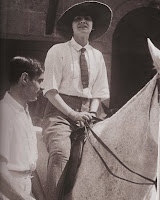
The eccentric empoverished cousin of Jackie Kennedy, Edith Bouvier Beale was an American socialite, fashion model and cabaret performer, best known as ‘Little Edie’. The documentary film Grey Gardens by Albert and David Maysles - set during the time when Little Edie lived with and took care of her mother in their East Hamptons estate with dozens of cats, raccoons and opossum, as well as a soon to be released biopic where she is played by Drew Barrymore, have made her an unlikely style icon.
A tall, blue-eyed blonde with a superb figure, Edie was one of the reigning beauties of East Hampton society. John Davis, Bouvier family historian, said “[She was] surpassing even the dark charm of [her cousin] Jacqueline Bouvier Kennedy.” She was known around town as ‘Body Beautiful Beale’ and had a steady following of beaus. To the dismay of her father, she dabbled in professional modeling. One of her photos was displayed in the studio window of famed photographer Louis Bachrach. Another hung, unauthorized, in an elevator at Macy’s in Manhattan.
Though never married, it is believed that she had proposals from Joe Kennedy Jr. and J. Paul Getty. She once dated maverick Howard Hughes, however her one true love was Julius Krug, former US Interior Secretary. Her mother though apparently scared off every suitor Edie ever had for fear that she would one day be left alone with no one to care for her.
After the death of her mother in 1977, Edie moved around the country after finally settling in Florida to pursue a life of quiet isolation. Edie had been dead for five days when she was discovered by her nephew. A daily swimmer until her death, aged 84, she was probably wearing her signature scarf and a swimsuit.
Her transformation into a fashion museLittle Edie Beale was indeed first discovered by fashion. Cashmere sweaters draped around her head, upside-down skirts, pantyhose sarongs and trouser minis are a few of her trademark staples that fashion designers, thrilled by her unconventional creativity, were quick to reinvent on the runway. Almost ten years after her death in 1997, Little Edie had reached the status of a very unlikely style icon.
Her influence was evident in Galliano’s (pictured left) spring 2008 R-T-W Collection and Marc Jacobs’ fall 2008 runway, with both collections featuring wools, cashmeres, chiffons and sequins worn, as Edie would have, in mismatched layers of leggings, skirts, coats, furs and turbans, all adorned by brooches. Edie’s new status as fashion muse has also lead to the new musical ‘Grey Gardens’, the Broadway version of the 1975 Maysles documentary that first exposed Beales’ fashion style.
A Fashion muse‘Grey Ga rden’s’ costume designer Catherine Marie Thomas confesses: “Little Edie used what she had to make a very specific style for herself. We spent hours thinking about how she manipulates clothing. She is a genius draper of fabric.”
rden’s’ costume designer Catherine Marie Thomas confesses: “Little Edie used what she had to make a very specific style for herself. We spent hours thinking about how she manipulates clothing. She is a genius draper of fabric.”
“The things she wore on her head had a lot of weight—sweater vests, heavy towels. How did she drape them so beautifully with only one pin? She also had this incredible sense of how to mix patterns. You would never know she had 10 pieces of clothing on.”
Little Edie never set out to be a style icon. Her style is based on instinct and a cert
ain disconnection from reality. With the inherent glamour of her past allied to the eccentric patchwork of her present, she wore what she could in her exceptional circumstances. Of her style she said: “I didn’t have time, taking care of mother, to get out and buy clothes. So I used what was left of mine and mothers in the attic”.
Now, as we stumble through economic recession, her make-do-and-mend approach p
roves even more relevant to fashion lovers, yet even billionaires such as actress Mary-Kate Olsen are drawn to her and her disheveled style. As with all great icons, it is her signature items that make her look.
Emulating her style is all about adopting a dressing-up-box approach to getting dressed: just play around with old clothes you’d stashed away, fur stoles included, and start every day like you have never heard of any fashion rules.
Why not begin by using brooches and various necklaces and bracelets, then add a white swimsuit (Edie wore hers not to swim but to dance) a turban and to round it all off, a smudge of red lipstick. It’s so wrong that it’s right.





